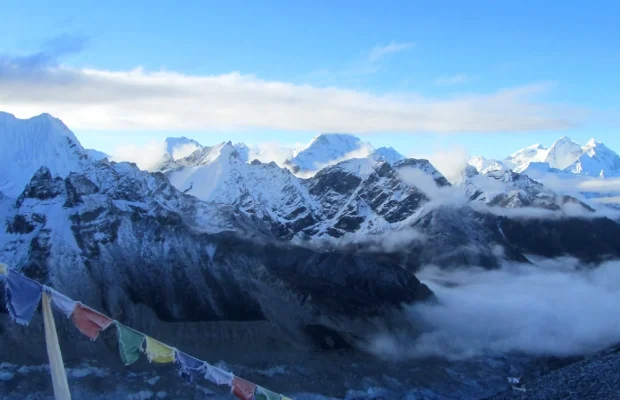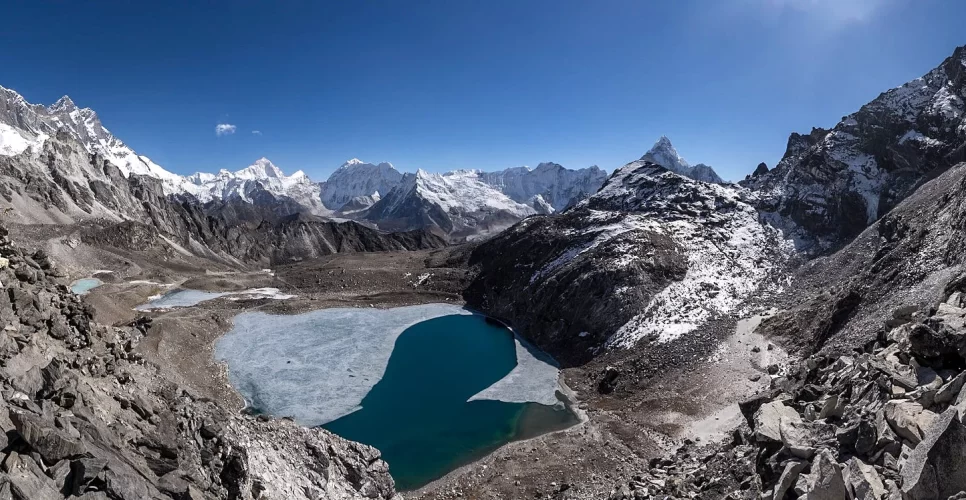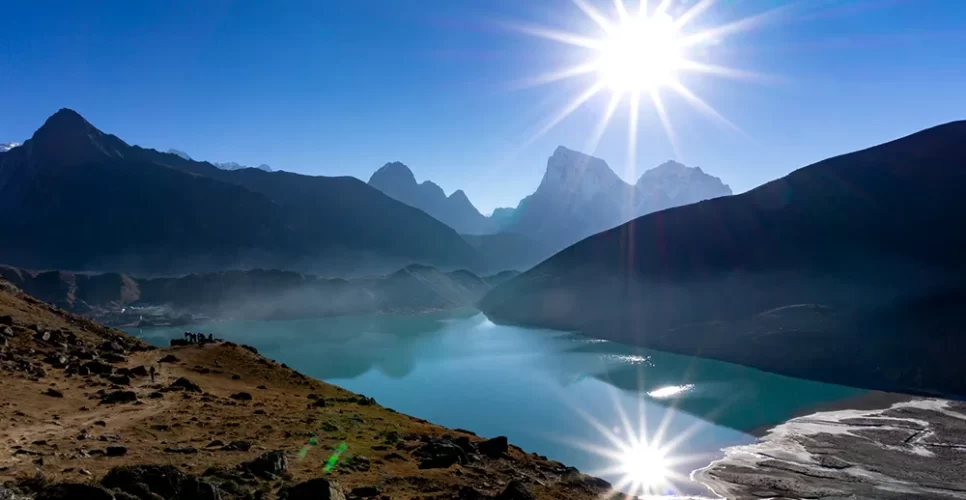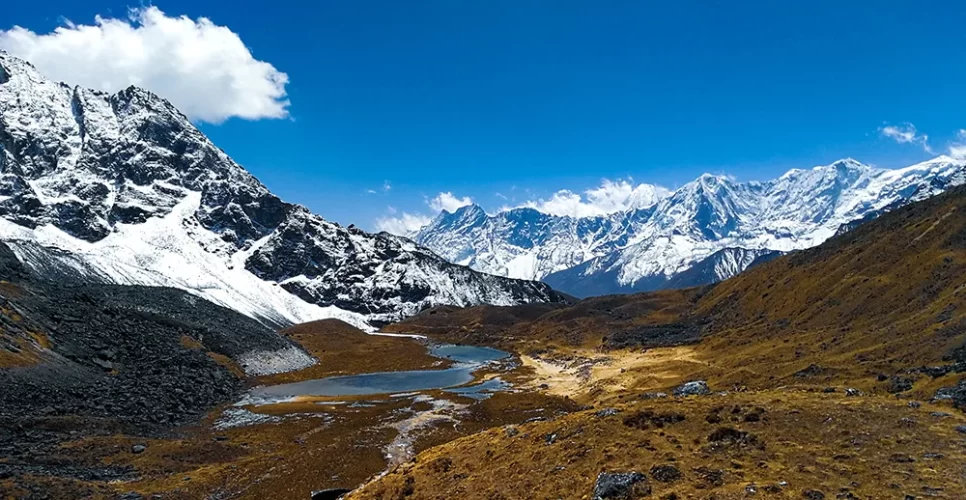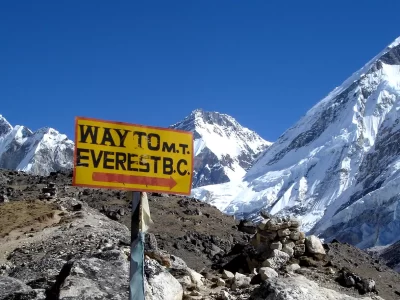Overview of Everest Three Passes Trek
Everest three passes trek, as the name indicates, takes you across three amazing mountain passes in Sagarmatha National Park. Everest three passes trek gives you an opportunity to see other very tall and impressive mountains beside Mount Everest. And quite frankly, these mountains dwarf Everest when it comes to beauty.
In the Everest three passes trek, you will walk along the dreamlike Himalayan mountain scenery to Lukla and start your tour right in the heart of the Everest hiking region.
You hike through spectacular landscapes to Namche Bazaar, the center of the Sherpa culture, and cross three passes to the base camp of the largest summit in the world. The climbing of Kala Patthar and the crossing of three 5000 meters passes offer fantastic views.
It all adds up to a beautiful tour that lasts almost three weeks and is undoubtedly one of the most impressive treks in the world, on which you are spoiled with an abundance of changing views.
The Everest three passes trek is also called Everest High Passes or King’s Road on Everest. The track is also impressive regarding altitude difference, kilometers and calories burned. But quite light in the sense that you don’t have to spend time and weight on camping and lugging food with you.
Everywhere within the daytime passage, there are guesthouses. The technical difficulty, though it is defined hard, is relatively easy, allowing you to pass it with limited equipment in the form of good trekking shoes and poles.
Know more about Everest Three Passes
The three passes included in this trek are Renjo La (5360m), Cho La (5420m), and Kongma La (5550m).
You reach the Renjo La pass as you head North from Namche Bazaar and cross the small town of Thame, known for its beautiful monastery. The air is pretty thin, but you will be rewarded with a great view of the mountains and prayer flags flapping in the wind to complete the picture.
The tour continues to Gokyo past the mighty Ngozumpa Glacier, which is fed by the 8188 m Cho Oyo. From the 5,330 m high Gokyo Ri panoramic mountain, you can enjoy the dream view of Mt. Everest, Lhotse, and Cho Oyu.
At the Cho-La Pass, you will be rewarded with the view of the Makalu looming in the distance and the impressive mountain of the 6,372 m high Arakam Tse.
After turning left into the throne room of the Himalayas and after a short effort, you are standing on the viewing platform of Kala Patthar. The third stroke follows with the crossing of the Kongma La Pass, and you are already in the Imja Khola Valley. The breathtaking, almost four thousand meters high Lhotse Wall almost takes your breath away. Behind are mountains such as Island Peak, Lhotse Shar, Kali Himal, and Baruntse.
You can go it both clockwise and counterclockwise. But it is not desirable to go clockwise due to various circumstances.
How to get there?
The Everest three passes trek is an alternative route to the classic Everest Base Camp route from where the conquering of the highest summit takes place. This trek is, however, different because it provides a radial exit in the middle of the route to the EBC. You can complete this trek clockwise or counterclockwise.
After you arrive in the capital, your genuine trek begins as you reach Phakding via Lukla. You will cross multiple suspension bridges, including the famous Edmund Hilary bridge, along the coast of the Dudh Koshi and Bhote Koshi rivers.
After a brief stay at Namche Bazaar, you will travel through the small Sherpa settlements of Tengboche, Dingboche, Chukhung, and Lobuche. Depending on the season of your tour, the pink rhododendron forests, birds chirping, and green vegetation with mind-boggling views of mountains will greet you.
You will also ascent the Kala Patthar and Gokyo Ri and take a short tour of Everest Base Camp as you pass along the three passes. The small Thame town will give you an opportunity to glance at the local culture and visit the famous Thame Monastery.
You will return following the same route from Namche Bazaar, Phakding, to Lukla.
You have to understand that this trip is on foot, except for a trip from Kathmandu to Lukla. You can take an internal flight to Lukla or hike to Lukla (depending on your liking). So we have planned this trip with sufficient rest and acclimatization days.
A typical Day in this trek
One of the benefits of this trek is the route you take. The route passes through the villages and paths, and you will always reach guest houses, lodges, or tea houses. So there’s no need to camp or carry tents. The same goes for the food. All food is on track in the canteens of the guesthouses. So there is no need to carry anything.
After leaving Kathmandu, your actual hike begins from Lukla. Every day, starting early in the morning, you will walk for 4 to 6 hours on average. The ascent and descent of the track will cross many stupas, monasteries, mountains, villages, and forests along the Dudh Koshi river.
The total trip takes about three weeks, and because of the acclimatization, the stages are quite short, and the route is rich in views.
Each day is characterized by a few hours of hiking, with a brief break for lunch or snacks and refreshments. As you reach your day’s target planned according to your itinerary, you will spend the day exploring the nearby towns or climbing short hills and peaks.
In the evening, you will have a comfortable room with a hot meal at your disposal. You will be greeted with opulent views of impressive mountains every morning. And every night, you can watch the starry sky in the absence of artificial city lights.
Trek Difficulty
Before embarking on this journey, you may search the internet regarding its difficulty, and you will mostly get the answer: the trek is technically demanding.
However, the Everest three passes are not technically challenging or demanding as suggested, as it doesn’t involve the use of ropes or other technical equipment. You may have to climb short hills or peaks such as Kala Patthar or Gokyo Ri, but it can be skipped if that’s what you desire.
There can be some steep slopes, but with sure footing, crossing these sections is relatively easy. So anyone who has already hiked the mountains and is in good physical and mental health can carry out this trek.
Although you should remember that you are in high altitudes, the weather can change dramatically, which can modify your itinerary, so you have to be prepared.
Among the three passes, Kongma La doesn’t pose any complications. The weather may change suddenly in the other two passes (Cho La and Renjo La). It does not usually happen, but we must be aware of this possible eventuality.
Since the trek takes approximately three weeks, good acclimatization is also needed throughout the entire ascent. Thus, we have planned the itinerary with gradual ascension and days for acclimatization.
Additionally, we have a team of guides who are professionals in the mountains; they know the risks and how to make the appropriate decisions based on the safety of the hikers.
Undoubtedly, this is a five-star trek, where you will enjoy the proximity of the highest emblematic peaks at your fingertips, and you will have the real sensation of being on the roof of the world.
Best Time
Spring or autumn is the most favorable time to go on the Everest Three Passes Trek. From the last days of September to the end of May, the climate is dry, and the view of the landscape and mountains are terrific.
From September to November or until the end of December, it is not that cold, the sky is clear, and the mountains are clearly visible. March to June is also a good trek season, as the weather here is stable.
The low season in winter can also be worthwhile, as the region is relatively quiet at this time. However, frosty temperatures at night must be expected here.
Summer is accompanied by the monsoon period, which is mostly not recommended for Everest three passes trek. However, in the monsoon period, trekking has charm as you meet a few trekkers, the local people have more time, and nature is in full bloom.
Of course, the views of the peaks can be blocked by clouds, but a trek during the summer can still be very beautiful. The blossoming, the few trekkers on the route, and the pleasant encounters with people even on the otherwise crowded route during the classic periods are just some of the arguments that support a trek in the monsoon period.
In principle, it is possible to hike in the Everest three passes all year round, but certain sections may be temporarily closed due to weather conditions.
Meals and Accommodation
The route to Everest three passes is full of basic accommodations, known as lodges or tea houses. You will retire for the night in these mountain lodges where you can shower and order food. The rooms are usually double or triple.
The decor inside the room is simple, with beds. Sometimes, there can be bedside table, and a chair. The beds have mattresses, pillows, and linens. You have to share the toilet, shower and sink with other travelers.
Almost all lodges have electricity; you can recharge the batteries. You have to pay for the charging and WIFI as you gain height. In most cases, it is possible to take a hot shower for an additional fee. You can ask for a bucket of hot water with a ladle where there is no hot shower.
You can eat a meal in the lodge you are staying. The menu is usually a standard set of dishes. The basic ingredients of the dishes are rice, potatoes, or noodles. You can add fried vegetables, cheese, eggs, canned tuna, or meat.
A full meal in the morning and evening costs $5-10 per person. Fruits are usually absent from the menu. The higher the lodge is located, the food price will be higher and you will have less choice in food choices.
Drinking water from streams in Nepal is not recommended, as you can pick up an infection. Bottled drinking water is sold at lodges for $1-4 per liter. You can use water purification tablets for safe drinking water.
Safety and Security
Regarding safety and security during the Everest three Passes trek, you don’t have to stress out. The trail is very secure, and we have a professional team of guides who will escort you throughout the trip.
They will take the appropriate decision and action when needed and ensure the ease of your trip.
Another aspect that makes this trip really secure and safe is there’s no need to carry any specific technical equipment or material. You have to step on snow, but the difficulty depends on individuality. Some may easily walk with trail-running shoes, while others need boots and snow guards. Some poles can give you confidence if you have to walk on snow, but they are also optional.
Another condition that may worry you is altitude sickness, which can appear from 2,400 meters above sea level. You may suffer from severe headaches and general malaise. However, taking certain precautions will help you avoid this problem, such as:
- Stay hydrated and drink 3 to 4 lt of water
- Acclimatize appropriately as specified by your agency
- Walk slowly and steadily
- Carry Diamox (medicine for such sickness)
- Avoid consuming alcohol, coffee, or soft drinks
- Have garlic soup and ginger tea
As for unpredictable weather conditions, the authority is always on constant alert, and helicopter evacuation is prompt.
Travel Insurance
It is essential to take good insurance for this trip. It is not to scare you, but the possibilities of altitude sickness are very present, and the trekking paths are not easy. So you may have some injury or illness along the way, so travel insurance during Everest three passes trek becomes mandatory.
A good insurance policy is a guarantor of payment for qualified treatment in an emergency. Without an insurance contract, you will have to pay clinic bills yourself. Even one insured event during the trip can repeatedly cover the cost of the policy.
Ensure your insurance covers up to or more than a 5000 m barrier. On this trek, you will move up to Kala Patthar and Gokyo Ri and take a short excursion to Everest Base Camp. The weather can suddenly change in three passes, so helicopter evacuation may be necessary.
The insurance policy cost depends on the tourist’s age, trip duration, place, and amount of insurance coverage. A minimum value of USD 10,000 is appropriate for this type of trek.




 Based on
Based on



